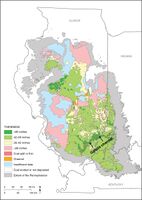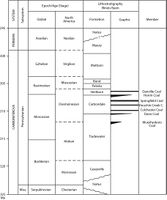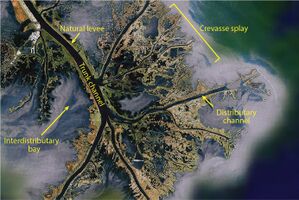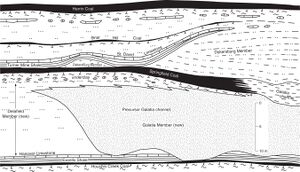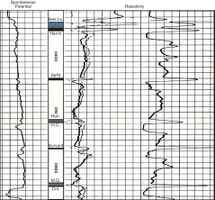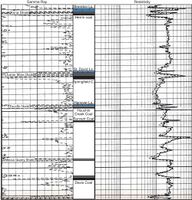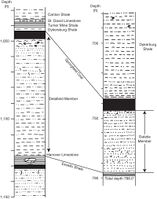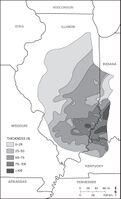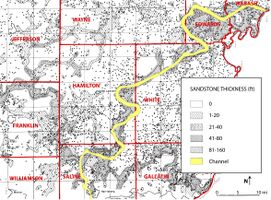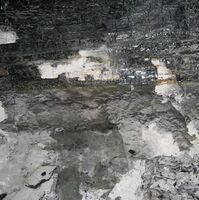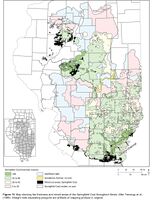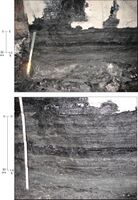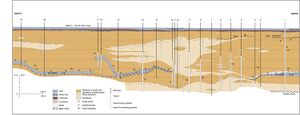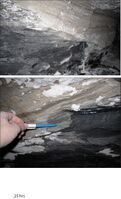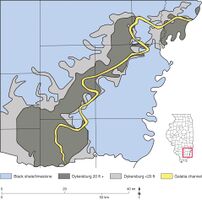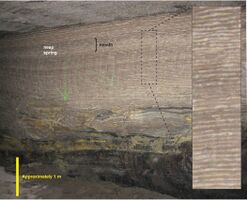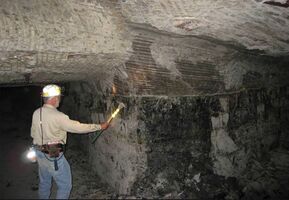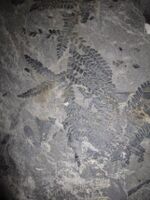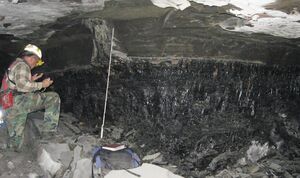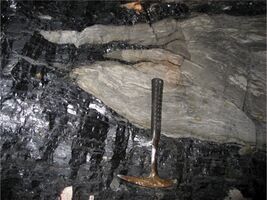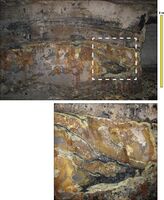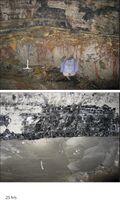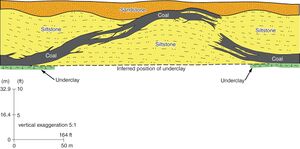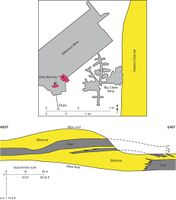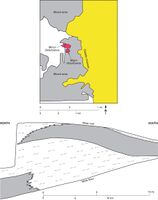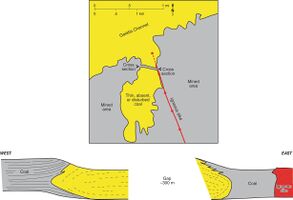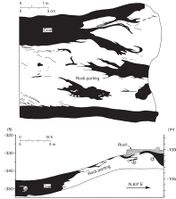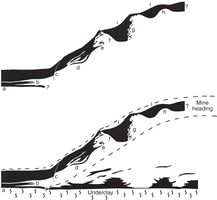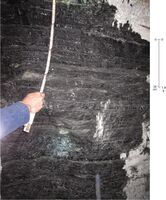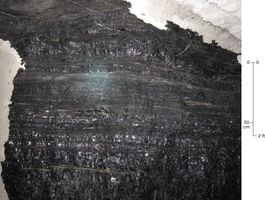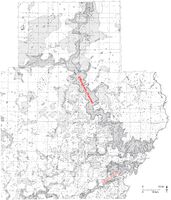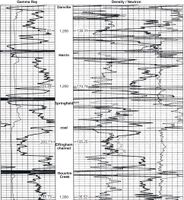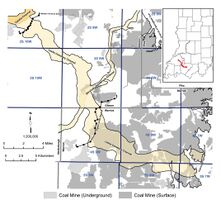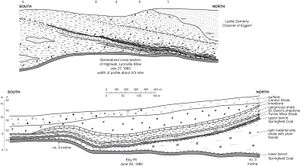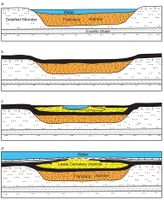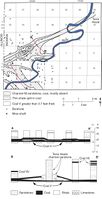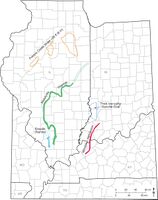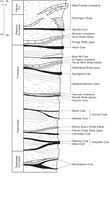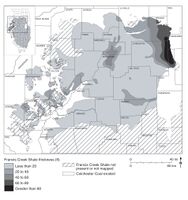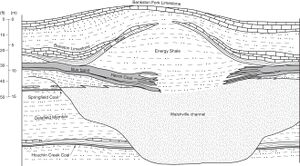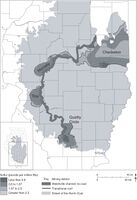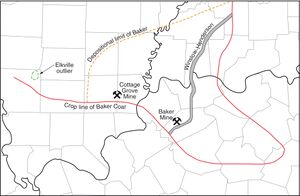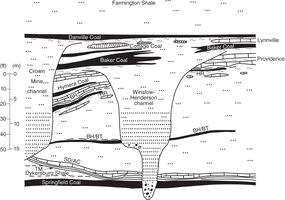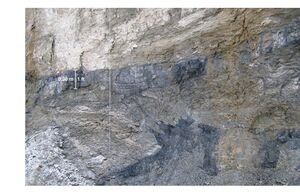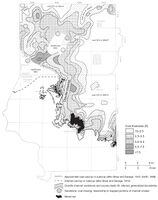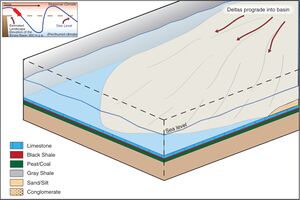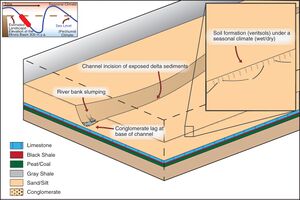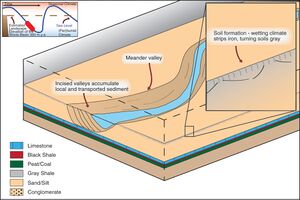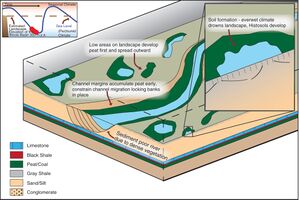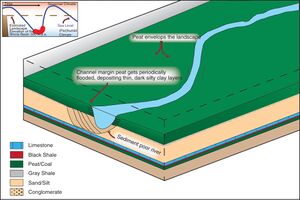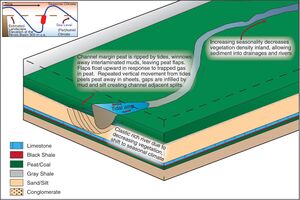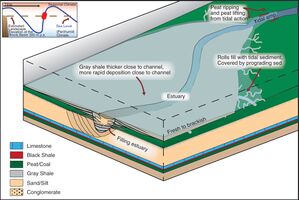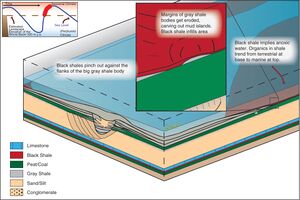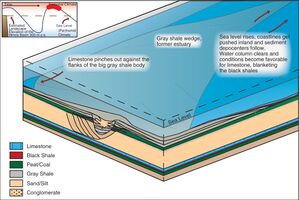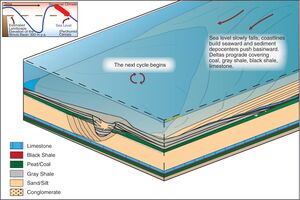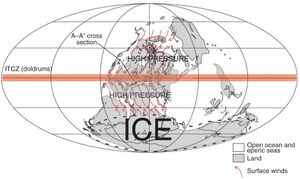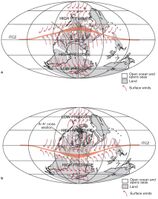Galatia Channel:Figures
Figure 1 Map of the Illinois Basin showing the extent of Pennsylvanian rocks, thickness of the Springfield Coal, and channels interrupting the coal. From Finley et al. (2005)[1]. Straight lines separating polygons are artifacts of mapping protocol in original.
Figure 2 Correlation chart showing the positions of key units within the Pennsylvanian Subsystem. Global and provincial stage boundaries and ages in millions of years (Ma) are after Gradstein et al. (2012)[2].
Figure 5a Wireline log illustrating the typical response of key units. (a) Electric log of Carter Oil No. 1 Beers well in sec. 28, T8S, R4E, Williamson County, Illinois (county no. 2107). B, Brereton Limestone; H, Herrin Coal; Sp, Springfield Coal; Han, Hanover Limestone; HC, Houchin Creek Coal; SV, Survant Coal; MQ, Mecca Quarry Shale; C, Colchester Coal. (b) Gamma-ray–resistivity log of Peabody Natural Gas No. 2 Short, in sec. 14, T7S, R7E, Hamilton County (county no. 25375).
Figure 5b Wireline log illustrating the typical response of key units. (a) Electric log of Carter Oil No. 1 Beers well in sec. 28, T8S, R4E, Williamson County, Illinois (county no. 2107). B, Brereton Limestone; H, Herrin Coal; Sp, Springfield Coal; Han, Hanover Limestone; HC, Houchin Creek Coal; SV, Survant Coal; MQ, Mecca Quarry Shale; C, Colchester Coal. (b) Gamma-ray–resistivity log of Peabody Natural Gas No. 2 Short, in sec. 14, T7S, R7E, Hamilton County (county no. 25375).
Figure 7 Isopach map of the Delafield Member. After Wanless et al. (1970)[3]. Thicknesses are in feet.
Figure 10 Map showing the thickness and mined areas of the Springfield Coal throughout Illinois. After Treworgy et al. (1999)[6]. Straight lines separating polygons are artifacts of mapping protocol in original.
Figure 13 Photographs showing the ragged, erosive contact between the light-colored siltstone of the Dykersburg Member and the underlying coaly shale of the Galatia Member in the channel crossing at the Galatia Mine, Saline County, Illinois. (a) View of the east wall of the entry. Coaly shale of the Galatia Member grades laterally northward (left, out of view) to shaly Springfield Coal. The pick is approximately 2 ft (60 cm) long. (b) Close-up view on the west wall of the entry. The heart of the Galatia channel is south (left) of view. Notice how erosion undercut the clay below layers of tough, fibrous peat.
Figure 14 Map showing the thickness of the Dykersburg Member in the vicinity of Galatia channel in southeastern Illinois. From Treworgy et al. (1999)[7].
Figure 15 Photograph showing rhythmic lamination in sandy facies of the Dykersburg Member in American Coal’s Millennium Mine, Saline County, Illinois. Enlarged view at right. Reprinted from Palaeogeography, Palaeoclimatology, Palaeoecology, v. 487, p. 74, W.A. DiMichele, S.D. Elrick, and W.J. Nelson, Vegetational zonation in a swamp forest, Middle Pennsylvanian, Illinois Basin, U.S.A., indicates niche differentiation in a wetland plant community. Copyright 2017, with permission from Elsevier.
Figure 20 Photographs showing the Springfield Coal “split” by massive siltstone in the Millennium Mine. The lower view is a close-up of the upper view. Notice the ragged splaying of coal layers into the siltstone from both above and below, with one coal stringer crossing diagonally from the lower to the upper coal “bench.” Combined with the absence of roots beneath the upper bench, such geometry implies that the upper part of the peat deposit was rafted. Enlarged view at right. Brown and yellow stains resulted from iron-rich water seeping through the coal.
Figure 21 Photographs of siltstone “splits” in the Springfield Coal. (a) Upper “bench” of coal splitting into multiple layers, with ragged splaying of lower coal layers at the Millennium Mine. (b) Contact between the upper coal bench and a massive siltstone split in American Coal’s Millennium Mine, approximately 0.6 mi (1 km) west of the main Galatia channel. Notice the complete absence of root traces in the siltstone.
Figure 26 Drawings from Meier and Harper (1981)[8] illustrating a major disruption of the Springfield Coal in AMAX Coal’s Wabash Mine in Wabash County, Illinois.
Figure 27 (Top) Image of the major disturbance in the Wabash Mine. From Meier and Harper (1981). (Bottom) The same drawing with interpretation added, depicting the peat deposit torn asunder, with the upper part floated away from the lower. The seam height at the left side of the diagram is approximately 9 ft (2.7 m).
Figure 34 Maps of the Leslie Cemetery channel. (a) Regional map showing the relationship to other channels. (b) Map of the northern part of the Leslie Cemetery channel, with the thickness of the Folsomville Member. From Eggert (1984), The Leslie Cemetery and Francisco distributary fluvial channels in the Petersburg Formation (Pennsylvanian) of Gibson County, Indiana, U.S.A., in R.A. Rahmani and R.M. Flores, eds., Sedimentology of coal and coal-bearing sequences: International Association of Sedimentologists, Special Publication 7 p. 311, 313. Copyright © 1984 The International Association of Sedimentologists.
Figure 36 Generalized sketches illustrating opposite margins of the Leslie Cemetery channel, as exposed in surface mines in the eastern half of 9S, 4W, Warrick County, Indiana. The upper image is from Peabody’s Lynnville Mine in July 1983, representing the northern half of the channel. The lower image is from Peabody’s Eby Pit in June 1982, representing the southern half of the channel.
Figure 37 Interpretive diagram showing sequential development of the Leslie Cemetery channel. (a) The Francisco channel is eroded and filled with sediment, largely sand. (b) Springfield peat accumulates in swale left by the abandoned channel. (c) Flowing water reoccupies the channel during the later stages of peat accumulation. Peat encroaches from the margins as the channel migrates laterally. (d) A marine incursion drowns the region and deposits black shale and limestone. Channel filling inverts the topography because of differential compaction.
Figure 38 Map and cross section of the Terre Haute channel. From Friedman (1960)[10]. Courtesy of the Indiana Geological and Water Survey. Lines of cross section are shown on the map.
Figure 43 Map showing the Walshville channel and sulfur content of the Herrin Coal. After Treworgy et al. (2000)[11]. The four named areas of low-sulfur coal are all associated with thick Energy Shale adjacent to the channel.
Figure 46 Disruption of the Danville Coal, with the seam “split” by a thick wedge of mudstone. Note the ragged splaying of coal into mudstone, with a thin coal stringer crossing diagonally from the lower to upper “bench.” The site is the box cut at a portal of the Prosperity Mine in Gibson County, Indiana.
Figure 47 Map showing the thickness of the Murphysboro Coal near the Oraville channel in Jackson and Perry Counties, southwestern Illinois. From Jacobson (1983)[12]
Figure 59 Conceptual model of Pangea during a glacial episode of the Pennsylvanian. From Cecil, C.B., F.T. Dulong, R.R. West, R. Stamm, B. Wardlaw, and N.T. Edgar, 2003b, Climate controls on the stratigraphy of a Middle Pennsylvanian cyclothem in North America, in C.B. Cecil and N.T. Edgar, eds., Climate controls on stratigraphy: SEPM Special Publication 77, p. 151–180. Copyright © 2003, used with permission of SEPM; permission conveyed through Copyright Clearance Center, Inc. ITCZ, intertropical convergence zone.
Figure 60 Conceptual model of Pangea during an interglacial episode of the Pennsylvanian. From Cecil, C.B., F.T. Dulong, R.R. West, R. Stamm, B. Wardlaw, and N.T. Edgar, 2003b, Climate controls on the stratigraphy of a Middle Pennsylvanian cyclothem in North America, in C.B. Cecil and N.T. Edgar, eds., Climate controls on stratigraphy: SEPM Special Publication 77, p. 151–180. Copyright © 2003, used with permission of SEPM; permission conveyed through Copyright Clearance Center, Inc. ITCZ, intertropical convergence zone.
Primary Source
References
- ↑ Finley, R., and Midwest Geological Sequestration Consortium, 2005, An assessment of geological carbon sequestration options in the Illinois Basin: Illinois State Geological Survey, final report to U.S. Department of Energy, contract DE-FC26-03NT41994, 477 p.
- ↑ Gradstein, F.M., J.G. Ogg, M.D. Schmitz, and G.M. Ogg, 2012, The geologic time scale 2012, 1st ed.: Amsterdam, Elsevier, 1,144 p.
- ↑ Wanless, H.R., J.R. Baroffio, J.C. Gamble, J.C. Horne, D.R. Orlopp, A. RochaCampos, J.E. Souter, P.C. Trescott, R.S. Vail, and C.R. Wright, 1970, Late Paleozoic deltas in the central and eastern United States, in J.P. Morgan and R.H. Shaver, eds., Deltaic sedimentation, modern and ancient: Society of Economic Paleontologists and Mineralogists, Special Publication 15, p. 215–245, https://doi.org/10.2110/pec.70.11.0215
- ↑ Potter, P.E., 1962, Shape and distribution patterns of Pennsylvanian sand bodies in Illinois: Illinois State Geological Survey, Circular 339, 36 p., 3 pls.
- ↑ Hopkins, M.E., 1968, Harrisburg (No. 5) Coal reserves of southeastern Illinois: Illinois State Geological Survey, Circular 431, 25 p., 2 pl.
- ↑ Treworgy, C.G., C.P. Korose, C.A. Chenoweth, and D.L. North, 1999, Availability of the Springfield Coal for mining in Illinois: Illinois State Geological Survey, Illinois Minerals 118, 43 p.
- ↑ Treworgy, C.G., C.P. Korose, C.A. Chenoweth, and D.L. North, 1999, Availability of the Springfield Coal for mining in Illinois: Illinois State Geological Survey, Illinois Minerals 118, 43 p.
- ↑ Meier, D., and D. Harper, 1981, Geologic discontinuities and associated mining problems encountered in the Harrisburg (No. 5) Coal Member near the contemporaneous Galatia channel in the Wabash Mine, Illinois: Illinois State Geological Survey, unpublished manuscript, 20 p., 16 figs. (available from the ISGS Library).
- ↑ Potter, P.E., 1962, Shape and distribution patterns of Pennsylvanian sand bodies in Illinois: Illinois State Geological Survey, Circular 339, 36 p., 3 pls.
- ↑ Friedman, S.A., 1960, Channel-fill sandstones in the Middle Pennsylvanian rocks of Indiana: Indiana Geological Survey, Report of Progress No. 23, 59 p.
- ↑ Treworgy, C.G., C.P. Korose, C.A. Chenoweth, and D.L. North, 2000, Availability of the Springfield Coal for mining in Illinois, map summary of Illinois Minerals 118: Illinois State Geological Survey, 1 sheet, 1:500,000.
- ↑ Jacobson, R.J., 1983, Murphysboro Coal, Jackson and Perry Counties: Resources with low to medium sulfur potential: Illinois State Geological Survey, Illinois Mineral Notes 85, 19 p.
